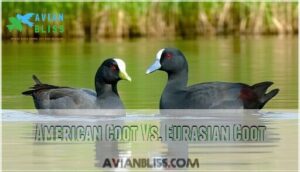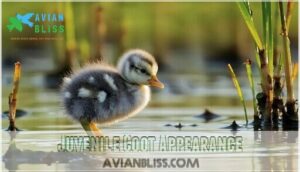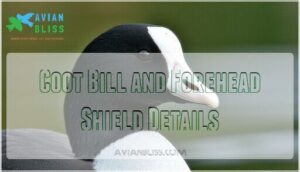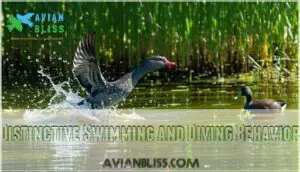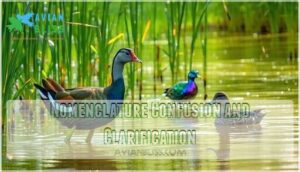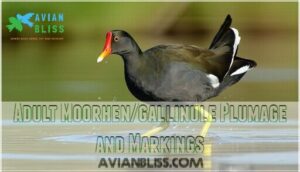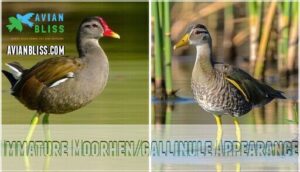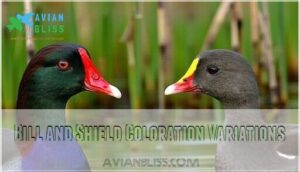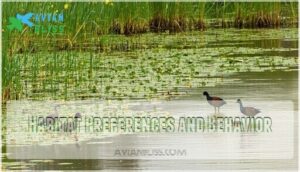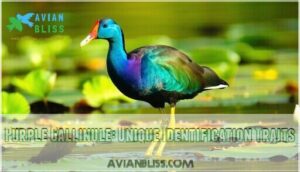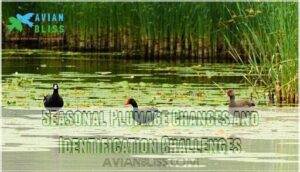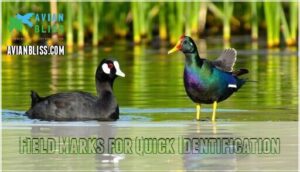This site is supported by our readers. We may earn a commission, at no cost to you, if you purchase through links.
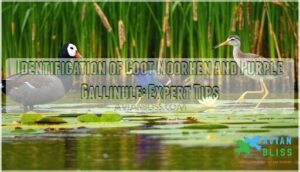
Coots sport distinctive white bills with dark shields and chunky, football-shaped bodies that make them look like feathered footballs floating on water.
Moorhens flash bright red bills with yellow tips and sleek frames, while purple gallinules dazzle with iridescent purple-blue plumage and banana-yellow legs that seem almost cartoonish.
Watch their movement patterns too—coots dive like submarines, moorhens pick delicately at the surface, and purple gallinules strut across lily pads like tightrope walkers.
These waterbirds become surprisingly easy to distinguish once you know their telltale signatures.
Table Of Contents
- Key Takeaways
- Distinguishing Features of Coots, Moorhens, and Gallinules
- Coot Identification: Key Characteristics
- Moorhen Vs. Common Gallinule: Spotting Differences
- Purple Gallinule: Unique Identification Traits
- Habitat Preferences for Accurate Identification
- Behavioral Clues for Species Differentiation
- Seasonal Plumage Changes and Identification Challenges
- Range and Distribution: Aiding Identification
- Field Marks for Quick Identification
- Technology and Tools for Accurate Identification
- Frequently Asked Questions (FAQs)
- Is a moorhen a common gallinule?
- How do habitat preferences affect moorhens and gallinules?
- What is the difference between coot and moorhen?
- What does a moorhen look like?
- What changes affect moorhens and gallinules?
- Are coot & moorhen a bird?
- What is the difference between a coot and a gallinule?
- What is the difference between a gallinule and a moorhen?
- What is the difference between purple and common Gallinules?
- What is the difference between a coot and a moorhen?
- Conclusion
Key Takeaways
- Master the "three B’s" approach – Focus on bills (white for coots, red-yellow for moorhens, blue-red-yellow for purple gallinules), bodies (chunky coots vs. sleek moorhens vs. lanky purple gallinules), and behavior (coots dive, moorhens pick at surfaces, purple gallinules walk on vegetation).
- Use habitat clues to narrow your options – Coots prefer open water for diving, moorhens stick to vegetation edges, and purple gallinules need floating plants they can walk on with their oversized yellow feet.
- Watch for distinctive white markings – Coots lack white undertail coverts, while both moorhens and purple gallinules flash white under their tails when swimming or walking.
- Pay attention to seasonal and geographic ranges – Purple gallinules only occur in the southeastern US and migrate completely out of temperate zones in winter, while coots and moorhens have broader distributions and different migration patterns.
Distinguishing Features of Coots, Moorhens, and Gallinules
When you spot these waterbirds in the marsh, distinguishing between coots, moorhens, and purple gallinules requires looking at specific physical features that separate each species.
You’ll need to observe their body shape, bill characteristics, plumage patterns, leg structures, and tail differences to make accurate identifications in the field.
Body Shape and Size Comparison
When comparing these marsh birds, you’ll notice distinct body proportions that make identification easier.
Coots sport chunky, football-shaped bodies with compact builds. Moorhens display sleek, streamlined silhouettes that cut through water efficiently. Purple gallinules showcase lanky frames with elongated legs perfect for vegetation walking.
Despite size overlap between species, these relative dimensions and weight differences remain consistent. Juvenile sizes may vary, but body shape characteristics persist across age groups, making them reliable field marks.
Bill and Forehead Shield Characteristics
Once you’ve sized up these water birds, their bills and shields offer the clearest identification clues.
These facial features work like nature’s ID cards, each species sporting distinct characteristics:
- American Coot bill: Bright white with matching frontal shield
- Moorhen shield: Vivid red forehead shield with yellow-tipped red bill
- Purple Gallinule bill: Blue base, red middle, yellow tip – like candy corn
- Shield shape: Coots have broader shields; moorhens display narrower ones
- Bill function: Each design reflects feeding habits and ecological niche
These distinctive bill patterns make field identification straightforward once you know what to look for.
Plumage Coloration and Patterns
Plumage coloration serves as your visual roadmap to identification.
American Coots display uniform dark blue-gray to black adult plumage, while Common Gallinules showcase charcoal-gray bodies with distinctive white undertail coverts.
Juvenile coots appear browner with paler throats.
Purple Gallinules steal the show with iridescent purple-blue feather colors creating stunning plumage iridescence.
Environmental factors influence feather pigments, occasionally producing color mutations or species hybrids with atypical patterned plumage, though natural camouflage patterns remain consistent within each species.
Leg and Foot Structures
Frequently, these waterbirds reveal their identity through distinctive leg and foot structures that reflect their unique lifestyles.
Each species has evolved specialized adaptations for their preferred habitats and foraging methods.
- American Coots: Feature lobed toes instead of webbed feet, with gray-green leg coloration and smaller foot size optimized for swimming
- Common Moorhens/Gallinules: Display long, slender toes with yellow-green leg color and moderate foot size for walking on floating vegetation
- Purple Gallinules: Showcase oversized feet with extremely long toe length and bright yellow leg coloration, providing superior climbing ability on aquatic plants
Tail Feather Differences
When observing these waterbirds from behind or below, you’ll notice tail feathers reveal key identification clues.
Coots display remarkably short, stubby tails that barely extend past their bodies.
In contrast, moorhens and purple gallinules sport longer tails with distinct white undertail coverts that flash conspicuously during swimming or walking.
These color variations and tail length differences provide reliable field marks for distinguishing between species.
Coot Identification: Key Characteristics
You’ll quickly recognize American Coots by their distinctive white bills and forehead shields, which set them apart from their darker-billed relatives.
These chunky, all-black waterbirds display unique lobed toes and aggressive diving behavior that makes identification straightforward once you know what to look for.
American Coot Vs. Eurasian Coot
American Coots and Eurasian Coots share similar dark plumage but differ in key features. American Coots display charcoal-gray bodies with white bills featuring dark rings, plus small chestnut-tinted forehead shields.
Eurasian Coots show slaty-black plumage with solid white bill and shield combinations. Notice the leg structure differences: American Coots have greenish-yellow legs while Eurasians sport blue-gray coloring with longer toe lobes for enhanced swimming.
The coots’ behavior is characterized by their presence in slow moving waters which influences their social interactions and habitat preferences.
Adult Coot Plumage and Markings
Understanding these two species helps you recognize adult coot plumage more precisely.
You’ll spot their signature dark colors – that sleek black plumage with subtle blue-gray undertones.
The white shield and matching bill characteristics create striking contrast against their body.
Notice the plumage coloration appears almost charcoal-like, while white undertail coverts flash when they swim.
These adult markings make identification straightforward once you know what to look for.
Juvenile Coot Appearance
Young coots don’t match their sleek parents.
These downy feathers create a mottled grayish-brown appearance with distinctive white patches on neck and breast areas.
Their beak color starts pale yellow-orange, lacking the bright white adult plumage characteristic.
Leg development shows yellowish tones rather than dark gray.
Juvenile molting gradually transforms their plumage patterns toward mature coloration.
Juvenile appearance features:
- Brownish-gray plumage coloration with white throat patches
- Pale yellow-orange bill characteristics instead of white
- Yellowish leg coloration before darkening
- Fluffy, less streamlined body shape
- Gradual feather replacement during growth phases
Coot Bill and Forehead Shield Details
You’ll recognize an American Coot’s bill characteristics instantly – that brilliant white, chicken-like beak paired with a smooth, white forehead shield.
This distinctive shield shape extends seamlessly from the bill up the forehead, creating facial markings that look like nature’s helmet.
The beak structure remains consistent across age groups, though juveniles show slightly duller tones.
These forehead patterns distinguish coots from moorhens definitively.
Distinctive Swimming and Diving Behavior
Beyond their distinctive bill characteristics, coots display remarkably different swimming and diving behavior that makes identification straightforward.
When you watch coots in action, you’ll notice their powerful diving techniques as they completely submerge for aquatic vegetation, unlike moorhens that prefer surface feeding.
Their swimming and diving behavior includes several key patterns:
- High swimming speed with characteristic head-bobbing motion
- Forceful water entry creating noticeable splashes during dives
- Extended dive depth reaching bottom sediments for plant material
- Specialized foraging strategies targeting submerged roots and stems
- Territorial displays involving rapid surface runs before takeoff
Coots’ chunky body shape provides excellent buoyancy control, while their lobed toes act like natural flippers.
This combination of plumage coloration, bill characteristics, and habitat preferences creates a complete identification picture that separates them from their rail family relatives.
Moorhen Vs. Common Gallinule: Spotting Differences
You might think moorhens and common gallinules are different species, but here’s the taxonomic twist that confuses many birders.
The common moorhen (Gallinula chloropus) and common gallinule are actually the same species – American ornithologists recently adopted the "gallinule" name to match international standards, which is a significant change to note the common name alignment.
Nomenclature Confusion and Clarification
Moving from coots to their confusing cousins, you’ll encounter some serious nomenclature confusion. The bird world’s naming game has flip-flopped over decades, creating classification challenges for everyone.
Understanding global conservation efforts is essential for protecting these species and their habitats. This is crucial for the survival of the species, as it involves protecting their habitats and ensuring their well-being.
| Species | Scientific Name | Current Name | Previous Name |
|---|---|---|---|
| Gallinula galeata | New World | Common Gallinule | Florida Gallinule |
| Gallinula chloropus | Old World | Eurasian Moorhen | Common Moorhen |
| Porphyrio martinica | Americas | Purple Gallinule | Purple Gallinule |
The 2011 taxonomic split finally separated these species properly, ending terminology standards chaos that plagued bird identification for years. This change has helped in reducing nomenclature confusion and has made it easier to identify the species correctly, which is a significant step forward in global conservation efforts.
Adult Moorhen/gallinule Plumage and Markings
Adult moorhens sport charcoal-gray bodies with striking red bills and forehead shields.
Their distinctive markings include white undertail coverts and lateral body stripes that create clean contrast lines.
| Feature | Adult Plumage | Bill Characteristics |
|---|---|---|
| Body Color | Charcoal-gray base | Bright red with yellow tip |
| Marking Differences | White lateral stripe | Red frontal shield |
| Leg and Foot Structures | Greenish-yellow legs | Long, slender toes |
These plumage patterns and color variations make field identification straightforward once you know what to look for.
Immature Moorhen/gallinule Appearance
Young moorhens’ plumage variations reveal subtle identification clues.
Immature moorhen and immature common gallinule appearances differ in key areas, though juvenile markings overlap substantially.
Feather patterns show brownish tones before adult coloration develops.
| Feature | Immature Moorhen | Immature Common Gallinule |
|---|---|---|
| Overall Plumage | Brownish-gray with mottled appearance | Darker gray-brown coloration |
| Leg Color | Greenish-yellow tones | Yellowish-green hues |
| Bill Shape | Duller red with yellow tip | Pale yellowish coloration |
| Juvenile Appearance | Lacks prominent frontal shield | Reduced shield development |
Bill and Shield Coloration Variations
The bill and shield of moorhens reveal nature’s artistry through striking color variations. Adult birds display brilliant red frontal shields contrasting with yellow-tipped red bills, while juveniles show duller tones.
| Feature | Adult | Juvenile |
|---|---|---|
| Shield Colors | Bright red | Brownish-gray |
| Bill Patterns | Red with yellow tip | Duller red/brown |
| Facial Marks | Distinct white undertail | Less prominent |
| Beak Shapes | Pointed, triangular | Similar but smaller |
These bill characteristics intensify during breeding season, making identification easier when you’re watching these marsh dwellers navigate their watery homes.
Habitat Preferences and Behavior
Beyond bill coloration differences, habitat preferences and behavior reveal key identification clues.
Both species thrive in freshwater marshes with dense aquatic vegetation, but their foraging habits differ subtly. Water depth preferences vary—moorhens favor slightly deeper areas while common gallinules stick to shallower zones.
Their social interactions and nesting sites show distinct patterns worth observing.
| Behavior | Moorhen | Common Gallinule |
|---|---|---|
| Water Depth | Deeper areas (2-3 feet) | Shallow zones (6-18 inches) |
| Foraging Style | Methodical plant picking | Quick invertebrate snatching |
| Social Groups | Solitary or pairs | Small family clusters |
| Migration Patterns | Year-round residents south | Seasonal movement north |
Purple Gallinule: Unique Identification Traits
You’ll find the Purple Gallinule stands apart from its rail family cousins with its stunning iridescent plumage that shifts from deep purple to brilliant blue-green depending on the light.
This tropical beauty’s oversized yellow feet and distinctive climbing abilities make it one of the most recognizable wetland birds once you know what to look for, with its unique features being a key part of its recognizable appearance.
Adult Purple Gallinule Coloration
When you spot a Purple Gallinule strutting through the marsh, you’re witnessing nature’s living jewel.
Purple gallinules strut through marshes like living jewels, their iridescent feathers catching sunlight
The adult Purple Gallinule showcases stunning Plumage Coloration that rivals any tropical bird:
- Iridescent blue and purple body feathers that shimmer with Hue Changes
- Glossy dark green back and wings with bronze Sheen Effects
- Vibrant Iridescent Feathers creating mesmerizing Color Variations
These Plumage Patterns make identification straightforward—no other marsh bird displays such spectacular iridescent brilliance.
Juvenile Purple Gallinule Appearance
Unlike their stunning parents, juvenile Purple Gallinules sport a completely different look that’ll throw you for a loop.
These young birds display muted brown-bronze Plumage Coloration that’s worlds apart from adult vibrancy.
Here’s what sets juvenile Purple Gallinules apart:
- Overall brownish plumage with buff underparts
- Pale greenish-yellow bill lacking adult intensity
- Gradual Plumage Variation as they mature over months
Juvenile Markings create fascinating identification challenges during developmental periods.
Leg and Foot Coloration
Looking beyond the purple gallinule’s colorful plumage, you’ll find their leg and foot coloration equally distinctive.
Adult purple gallinules sport bright school-bus yellow legs and oversized feet with extra-long toes—perfect for their marsh lifestyle.
| Feature | Adult | Juvenile |
|---|---|---|
| Leg Colors | Bright yellow | Dull gray-green |
| Foot Patterns | Uniform yellow | Muted coloring |
| Toe Shapes | Long, slender | Long, slender |
| Claw Colors | Dark gray | Dark gray |
| Ankle Feathers | None visible | None visible |
These yellow legs contrast sharply with their multicolored body, making field identification straightforward when you spot those unmistakable bright supports beneath their iridescent frame.
Distinctive Walking and Climbing Behavior
Purple gallinules showcase remarkable locomotion on vegetation through their specialized leg and foot structures.
Watch these marsh acrobats step gracefully across lily pads like feathered tightrope walkers
These marsh acrobats demonstrate extraordinary fancy footwork that sets them apart from other rails.
Key walking and climbing behaviors include:
- Stride Length – They take deliberate, measured steps to distribute weight evenly across floating plants
- Foot Grip – Their oversized feet provide exceptional traction on slippery lily pads and stems
- Climbing Styles – They’ll scale cattails and rushes vertically using their strong leg movement
- Walking Patterns – Watch for their characteristic high-stepping gait that minimizes surface contact
This distinctive walking and climbing behavior makes identification straightforward when you spot their ballet-like performance across wetland vegetation.
Habitat Preferences for Accurate Identification
Understanding where each species prefers to live can be your best clue for accurate identification in the field.
You’ll find that habitat preferences often provide the first hint about which bird you’re observing, especially when physical features aren’t immediately clear, and this can be a key factor in making a correct identification.
Coot Favored Environments
When identifying coots in the field, their habitat preferences provide vital clues.
These wetland ninjas favor freshwater marshes with moderate water depth and abundant aquatic vegetation.
| Habitat Type | Water Depth | Vegetation Density |
|---|---|---|
| Ponds | 1-4 feet | Dense emergent plants |
| Lakes | Variable | Moderate aquatic plants |
| Marshes | Shallow-deep | Heavy cattails/reeds |
| Reservoirs | 2-8 feet | Scattered vegetation |
Coots need open water for diving while requiring dense shoreline features for nesting.
Their wetland habitats must balance swimming space with protective cover, making them predictable residents of well-vegetated water bodies.
Moorhen and Common Gallinule Habitats
Moorhens and common gallinules call freshwater marshes, ponds, and slow-moving rivers home. These wetland ninjas thrive in marsh environments where dense vegetation provides perfect cover.
They prefer shallow water depths with abundant aquatic plants for foraging. You’ll spot their red bills emerging from aquatic vegetation in these productive wetland ecosystems.
- Hidden gems: They’re masters at staying concealed in thick reeds and cattails
- Patient rewards: The longer you watch quietly, the more behaviors you’ll witness
- Edge dwellers: Look for movement where water meets vegetation – that’s their sweet spot
- Morning magic: Early hours offer the best chances to see them actively foraging
- Quiet victories: Your stillness determines whether they reveal themselves or remain hidden
Purple Gallinule Preferred Ecosystems
When you’re tracking down these stunning birds, purple gallinules showcase distinct habitat preferences that set them apart from their wetland cousins.
These vibrant species thrive in freshwater marshes where dense vegetation provides both cover and cuisine. You’ll spot them traversing freshwater habitats like ponds, canals, and rice fields – places where marsh ecology supports their specialized lifestyle.
Unlike coots that prefer open water, purple gallinules need aquatic vegetation they can walk on with their oversized yellow feet.
| Habitat Feature | Purple Gallinule Need | Why It Matters |
|---|---|---|
| Dense cattails/rushes | Essential cover | Protection from predators |
| Floating lily pads | Walking platforms | Supports their weight perfectly |
| Shallow water edges | Foraging zones | Easy access to invertebrates |
Wetland conservation efforts focus on maintaining this ecosystem diversity because these birds require specific conditions. They’re like nature’s tightrope walkers – needing that perfect balance of water, vegetation, and food sources to call a place home.
Seasonal Habitat Variations
Throughout the year, you’ll notice these wetland species shifting their habitat preferences as conditions change.
Water levels dramatically affect where you’ll find them – coots favor deeper waters that freeze later, while moorhens stick to shallow edges that thaw first.
Seasonal migrations bring fascinating habitat shifts: purple gallinules abandon northern freshwater marshes for tropical wetlands, following temperature gradients.
Climate effects trigger these migratory patterns, with coots forming massive winter flocks on ice-free lakes.
Migration patterns reveal species-specific timing – moorhens move short distances, while purple gallinules undertake epic journeys to Central America, making winter identification quite different from breeding season encounters.
Impact of Habitat on Plumage Variations
Water chemistry shapes the vibrant world of these rail species in remarkable ways. Dietary Influence from nutrient-rich wetlands provides coots with 25% more carotenoids, creating brighter shields compared to urban pond dwellers.
Moorhens and purple gallinules similarly benefit from carotenoid-rich invertebrates, with purple gallinules showing 20% increased plumage reflectance in inundated marshes.
Pollution Effects can dramatically alter appearances—mercury exposure brightens crowns by 12%, while lead reduces UV reflectance by 5%, potentially weakening mate signals. Sunlight Exposure and humidity follow Gloger’s rule, with subtropical coots appearing 18% darker than northern populations.
Considering these factors, regional climate impacts the selection of suitable nesting sites.
Key environmental factors affecting plumage coloration include:
- Water Chemistry – Nutrient levels determine carotenoid availability for bright coloration
- Vegetation Camouflage – Reed-dwelling moorhens develop olive-tinged flanks matching surroundings
- Substrate Matching – Purple gallinules show 17% more blue-purple hues in waterlily habitats
- Seasonal Resource Shifts – Dry seasons reduce feather quality by 15% across species
- Humidity Gradients – Wet climates enhance iridescence by 23% in purple gallinules
Behavioral Clues for Species Differentiation
You’ll notice distinct behavioral patterns that reveal each species’ identity more clearly than physical features alone.
Watch how they move through water and interact with their surroundings – coots paddle with their lobed toes and dive headfirst for submerged vegetation, while moorhens pick delicately at the water’s surface and purple gallinules step confidently across floating lily pads like feathered tightrope walkers.
Coot Swimming and Diving Patterns
Watching coots in action reveals their remarkable aquatic abilities.
Unlike moorhens that stick to shallow areas, American Coots excel at deep-water activities.
Their bill and shield design helps them navigate underwater, while specialized feather buoyancy keeps them afloat between dives.
| Behavior | Coots | Other Rails |
|---|---|---|
| Water Entry | Head-first plunge | Gradual wading |
| Diving Depths | 3-10 feet deep | Surface feeding |
| Swimming Speed | Fast, direct motion | Slow, cautious |
| Dive Patterns | Repeated sequences | Rare submersion |
You’ll notice Eurasian Coots share similar swimming and diving behavior patterns, making this a reliable identification feature across coot species.
Moorhen and Common Gallinule Foraging Behavior
Foraging behavior reveals key differences between these wetland species.
Moorhens prefer shallow water depths, actively diving and swimming to catch invertebrate prey like snails and insects. Common gallinules showcase different feeding habits, staying closer to water surfaces while picking aquatic plants with methodical precision.
Their habitat preferences slightly overlap, but distinct foraging strategies help with identification.
Key Foraging Differences:
- Moorhen identification: Watch for head-bobbing dives and underwater pursuits of small creatures in deeper water areas
- Gallinule identification: Look for surface-level plant picking and cautious wading through dense vegetation margins
- Swimming and diving behavior: Moorhens dive confidently while gallinules prefer tip-feeding like dabbling ducks
- Water depth preferences: Moorhens venture into open water; gallinules stick to protective shallow zones near cover
Purple Gallinule Locomotion on Vegetation
When you spot a Purple Gallinule, watch how it seems to walk on water—literally! Their long toes and Balance Techniques distribute weight perfectly across lily pads and floating vegetation.
This Vegetation Walking ability, combined with graceful Plant Climbing and Water Striding, makes their locomotion unmistakable.
Gallinule chicks inherit this remarkable walking and climbing behavior, helping distinguish them from coots.
Vocalizations and Calls
Beyond the physical features you’ve observed while watching these birds navigate vegetation, their voices tell another story. Each species has developed distinct call patterns that help you identify them even when you can’t see them clearly.
Here’s how their vocalizations differ:
- American Coots produce low, guttural grunts and squeaks that sound almost mechanical. Their calls lack the musical quality you’ll hear in other waterbirds, resembling more of a creaky gate than bird songs.
- Moorhens and Common Gallinules offer a diverse vocal repertoire including soft clucks, sharp "kek-kek-kek" alarm calls, and explosive "krrruk" sounds when startled. Their frequency analysis shows varied pitch ranges.
- Purple Gallinules deliver that unmistakable descending whistle – a clear, ringing "kleeeer" that drops in pitch. This call carries well across marshlands and stands out from background bird sounds.
Sound recording these vocalizations with analysis software helps confirm your visual identification, especially during dawn and dusk when lighting makes field marks harder to distinguish.
Social Behavior and Flock Dynamics
Beyond listening to calls, you’ll notice these birds have distinct social dynamics that make identification easier. Coots naturally gravitate toward flock formation, especially during migration when hundreds gather on open water.
You’ll spot them swimming in coordinated groups with clear social hierarchy – dominant birds claiming prime feeding spots while subordinates stay on the periphery.
Moorhens and gallinules prefer different approaches. They’re typically loners or form small family units, rarely joining large gatherings. During breeding season, moorhens become surprisingly aggressive in territorial defense, chasing intruders with dramatic wing-flapping displays.
Group foraging patterns also differ substantially. Coots dive together in synchronized waves, while moorhens pick methodically through vegetation alone. Purple gallinules show unique social behavior – they’ll cooperatively build floating nests with family members helping.
| Species | Typical Group Size | Territorial Behavior | Breeding Cooperation | Foraging Style | Winter Flocking |
|---|---|---|---|---|---|
| American Coot | 50-200+ birds | Moderate | Limited | Synchronized diving | Large rafts |
| Common Moorhen | 1-4 birds | High during breeding | Pair-bonded | Solitary picking | Small groups |
| Purple Gallinule | 2-6 birds | Low | Family helpers | Individual walking | Rare |
These flock dynamics combined with vocalizations and calls create reliable identification signatures you can recognize from considerable distances.
Seasonal Plumage Changes and Identification Challenges
You’ll encounter your biggest identification challenges when these waterbirds change their appearance throughout the year.
Seasonal molting, environmental factors, and occasional hybridization can transform familiar field marks into puzzling variations that even experienced birders find tricky to sort out, due to seasonal changes.
Breeding Vs. Non-breeding Plumage
Something tells you these birds are playing a seasonal game of dress-up.
During breeding season, you’ll notice their breeding plumage becomes incredibly vibrant—coots develop whiter bills, moorhens sport brighter red shields, and purple gallinules showcase stunning iridescent blues.
Here’s what changes:
- Color Variations: Bills, shields, and body plumage intensify dramatically
- Breeding Cues: Bright colors signal reproductive readiness to potential mates
- Seasonal Shifts: Nonbreeding plumage appears duller, muted, and less distinctive
- Adult Plumage: Fully mature birds show the most dramatic seasonal transformations
Molting Patterns and Timing
Understanding these birds’ molting patterns helps you navigate identification challenges throughout the year.
Each species follows distinct molting cycles, with seasonal shedding occurring at predictable intervals.
Feather shedding typically happens twice annually—complete molts replacing flight feathers and partial molts rejuvenating body plumage.
The process of bird molting is essential for maintaining healthy plumage and overall bird health.
| Species | Primary Molt Timing | Secondary Molt |
|---|---|---|
| American Coot | August-October | February-March |
| Common Moorhen | July-September | January-February |
| Purple Gallinule | August-September | March-April |
Juvenile coots undergo continuous plumage renewal during their first year, making identification tricky.
Adult birds show dramatic differences between breeding plumage and nonbreeding plumage.
Flock molting occurs simultaneously in coots, creating temporarily flightless groups.
Impact of Environment on Feather Coloration
Environmental factors substantially shape feather coloration in coots, moorhens, and gallinules through complex interactions.
Climate effects influence color variation by altering nutrient availability and stress hormones.
Environmental stress from pollution or habitat degradation can dull plumage coloration, while ideal conditions enhance feather pigmentation.
Diet quality directly affects carotenoid deposits, creating brighter hues.
Temperature extremes trigger physiological adaptation responses, modifying pigment production during molting patterns and affecting long-term identification reliability.
Hybridization and Atypical Plumages
While environmental factors influence plumage coloration, you’ll occasionally encounter birds that challenge standard field identification through hybridization and atypical plumages. These unusual variations can make coot identification particularly tricky.
Hybrid Birds between coots and gallinules produce fascinating intermediate characteristics. You might spot birds with coot-like body shapes but gallinule bill coloration, or swimming behaviors combined with unexpected plumage patterns. American Coot × Common Gallinule hybrids show blended features – thicker necks than pure gallinules yet smaller than coots, with intermediate bill structures and partial frontal shield coloration.
Genetic Variations and Color Mutations create striking Plumage Anomalies that’ll catch your eye. Leucism produces white patches while preserving normal eye color, creating dramatic pale birds against typical dark plumage.
These Feather Abnormalities don’t follow standard identification guides, so focus on:
- Bill characteristics and shield shape for species confirmation
- Body proportions and overall silhouette patterns
- Swimming behaviors and habitat preferences
Remember that atypical plumages remain rare but documented. When encountering unusual birds, photograph them and note behavioral clues alongside physical features for accurate identification.
Range and Distribution: Aiding Identification
You can narrow down your identification by understanding where each species naturally occurs and when they’re most likely to be present.
Knowing the geographical ranges and seasonal movements of coots, moorhens, and purple gallinules helps eliminate unlikely candidates and focuses your attention on the most probable species for your location and time of year.
Coot Global Distribution
American Coots inhabit diverse wetlands across their global distribution, from Canada’s southern regions through the United States to northern Mexico.
Migration patterns show northern populations moving south during winter, while southern birds remain year-round residents.
Climate impact and habitat loss increasingly affect their range overlaps with other waterfowl.
Geographic isolation creates distinct populations, though American Coots maintain connectivity across their expansive range through seasonal movements and adaptable habitat preferences.
Moorhen and Common Gallinule Range
While coots occupy broad territories, moorhens and common gallinules showcase equally impressive geographic ranges spanning multiple continents.
You’ll find these adaptable birds across diverse wetland ecosystems, from North American marshes to European rice paddies.
Their range and distribution patterns reveal fascinating habitat preferences that aid identification:
- Breeding grounds extend throughout temperate wetlands in North America and Eurasia
- Migration patterns show partial movements, with northern populations wintering southward
- Wintering areas include southern United States, Central America, and Mediterranean regions
- Breeding range overlaps substantially between species, requiring careful behavioral observation.
Understanding these distribution patterns helps you predict where you’ll encounter each species during different seasons.
Purple Gallinule Geographical Limits
Purple Gallinules inhabit a surprisingly narrow geographical range that’s worth knowing before you head out birdwatching.
Understanding their Geographic Isolation helps you avoid wild goose chases in the wrong locations.
Key Distribution Facts:
- Primary Habitat Range: Southeastern United States from Texas to Florida, extending through the Caribbean and Central America
- Migration Patterns: Northern populations migrate south for winter, while southern residents stay year-round
- Climate Impact: Prefer warm, subtropical to tropical zones with consistent temperatures above freezing
- Distribution Maps: Show concentrated populations in Louisiana, Florida Everglades, and coastal marshes
- Habitat Preferences: Limited to freshwater wetlands with dense emergent vegetation like cattails and pickerelweed
Their geographical limits mean you won’t find these vibrant birds wandering into northern states during breeding season.
Migratory Patterns and Timing
Timing your observations with migratory patterns gives you identification advantages throughout the year.
Migration Routes vary substantially among these species, with each following distinct Flyway Patterns. Understanding these patterns requires knowledge of bird migration basics.
| Species | Migration Timing | Wintering Grounds |
|---|---|---|
| American Coot | Oct-Nov / Mar-Apr | Southern US, Mexico |
| Common Gallinule | Limited movement | Year-round residents |
| Purple Gallinule | Aug-Sep / Apr-May | Central/South America |
Northern coots become winter visitors in southern wetlands, while Purple Gallinules completely vacate temperate zones. You’ll find Common Gallinules maintaining territories year-round in warmer climates, making Seasonal Timing essential for accurate identification.
These Stopover Sites often concentrate multiple species together.
Range Overlaps and Potential Confusion Areas
Recognizing where these three rail species coexist helps you pinpoint confusion hotspots.
Florida wetlands create the ultimate identification challenge, hosting all three species year-round in overlapping habitat zones.
- Florida marshes: All three species share identical freshwater habitats, creating maximum confusion potential
- Great Lakes coastal areas: American Coots and Common Gallinules breed together in emergent vegetation zones
- Gulf Coast wetlands: Year-round residents mix with seasonal migrants, complicating field identification
- Central American overlap zones: Purple and Common Gallinules share tropical marsh ecosystems across ranges
- Vagrant hotspots: Rare Purple Gallinule appearances outside normal range create unexpected identification puzzles
Field Marks for Quick Identification
When you spot these waterbirds at a distance, you’ll want to focus on a few key field marks that’ll give you an instant ID.
Each species has distinctive features that stand out even in challenging conditions, from body shape and bill color to how they move through the water.
These features include aspects such as body shape and bill color, which are crucial for identification, making them key to understanding the species.
Key Visual Cues for Each Species
Spotting these wetland birds becomes second nature once you know what to look for. Each species displays distinctive markings that set them apart from their marsh-dwelling cousins.
American Coot:
- Dark slate-gray to blackish plumage overall
- White bill with matching white forehead shield
- Chunky, duck-like body shape
- Dark legs with lobed toes
- Short tail feathers held upright
- Lacks white side stripes found on gallinules
Common Moorhen/Gallinule:
- Charcoal-gray body with darker head and neck
- Bright red bill with yellow tip
- Red forehead shield becomes prominent during breeding
- Distinctive white stripe running down each side
- White undertail coverts flash when tail flicks
- Long yellow-green legs and toes
- Medium-sized, sleeker than coots
Purple Gallinule:
- Iridescent purple-blue head, neck, and underparts
- Bronze-green back and wing feathers
- Bright blue forehead shield
- Red bill with yellow tip
- Brilliant yellow legs and oversized feet
- White undertail coverts like moorhens
- Lacks the white side stripe of moorhens
These head marks, beak shapes, leg colors, and tail lengths provide reliable identification points across all lighting conditions.
Silhouette Recognition Techniques
Master silhouette recognition when those perfect lighting conditions aren’t cooperating with you. Even at dawn or dusk, these visual cues will help you distinguish between species using shape analysis and form comparison.
Size and body structure: Coots display a stocky, duck-like build about chicken-sized, while moorhens and gallinules appear more slender and elegant. Notice how coots look chunky even from a distance—their robust frame contrasts sharply with the streamlined profiles of their relatives.
Posture study reveals key differences: Coots typically hold their tails low or parallel to water, creating a flat-backed silhouette. Moorhens and gallinules frequently cock their tails upward, flashing those distinctive white undertail coverts like little flags.
Flight patterns provide additional identification clues: Coots need running starts across water before becoming airborne, then maintain straight-line trajectories. This labored takeoff contrasts with moorhens and gallinules, who prefer quick dives or brief flights when threatened.
- Shadow identification becomes your secret weapon when backlit birds challenge traditional color-based methods
- Visual cues work even in challenging weather when rain or fog obscures detailed plumage features
- Coot identification confidence builds as you recognize their unmistakable chunky silhouettes against reedy backgrounds
In-flight Identification Tips
Catching birds in mid-air requires keen observation of specific flight characteristics that distinguish these three rail species.
You’ll notice distinctive wing patterns and flight styles that make inflight identification more manageable than you might expect.
Here’s what to watch for during flight observations:
- Wing span differences: Coots display shorter, rounded wings with rapid wingbeats, while purple gallinules show longer, broader wings with slower, more deliberate strokes
- Tail streams and body posture: Coots fly with legs trailing behind and necks extended, creating a streamlined silhouette, whereas gallinules often tuck their oversized yellow feet up against their bodies
- Flight pattern consistency: Moorhens maintain steady, direct flight paths with necks outstretched, while purple gallinules may appear more labored and erratic due to their heavier build
Feather visibility becomes essential when beak angles aren’t clearly visible.
Focus on silhouette recognition rather than color details, as these visual cues remain consistent regardless of lighting conditions.
The key is practicing these flight characteristics until they become second nature.
Distinguishing Features in Poor Lighting
When visibility drops, focus on silhouette recognition and key visual cues.
The Common Gallinule’s distinctive white undertail coverts remain visible even in shadows. American Coots appear more rounded without this white marking. Purple Gallinules show their oversized yellow feet and longer neck profile.
Bill characteristics like the Coot’s white shield still stand out in dim conditions, while plumage texture differences help distinguish species through shadow recognition techniques.
Understanding key field marks is essential for accurate identification of these species.
Common Misidentifications and How to Avoid Them
Between similar waterbirds like coots, moorhens, and purple gallinules, even experienced birders make mistakes.
These mix-ups happen because these species share wetland habitats and similar behaviors, creating identification puzzles that can stump anyone.
Here are five key distinctions to prevent Common Misidentifications:
- Bill Shapes and colors: Coots sport white bills, moorhens have red-and-yellow bills, purple gallinules show blue-red-yellow combinations
- Plumage Variations: Coots appear all-black, moorhens show gray-brown tones, purple gallinules display iridescent blues and purples
- Leg Colors: Coots have greenish legs with lobed toes, moorhens sport yellow-green legs, purple gallinules flash bright yellow legs
- Feather Patterns: Look for white undertail coverts on moorhens and purple gallinules versus plain black on coots
- Habitat Clues: Coots prefer open water, moorhens stick to vegetation edges, purple gallinules walk on floating plants
Focus on bill color first—it’s your most reliable field mark for quick Coot Identification versus Moorhens and Purple Gallinules. This approach prevents the most common Bird Identification errors in wetland environments.
Technology and Tools for Accurate Identification
You’ll need the right tools and technology to distinguish between these similar-looking waterbirds with confidence.
Modern field guides, identification apps, quality optics, and recording equipment can transform challenging bird encounters into successful identifications by capturing the subtle details that separate coots, moorhens, and purple gallinules in the field, using the right tools and technology.
Field Guides and Identification Apps
Today’s birder’s arsenal includes powerful digital resources that revolutionize field identification.
Modern Field Guides and Identification Apps deliver unprecedented App Accuracy through real-time Guide Updates and extensive databases.
These tools eliminate Common Misidentifications by providing instant access to Visual Cues, vocalizations, and range maps.
| Feature | Free Apps | Premium Apps |
|---|---|---|
| Digital Features | Basic species accounts, photos | Advanced filters, quiz modes |
| Offline Access | Limited database | Full offline functionality |
| User Reviews | Community ratings | Expert verification |
Popular apps like Merlin Bird ID and eBird offer Bird Identification through photo recognition and sound analysis.
A specialized tool exists for Gallinule identification.
Check User Reviews before downloading—they’ll reveal which apps excel at distinguishing your target species.
Offline Access proves invaluable in remote wetlands where cell service falters.
Binoculars and Spotting Scopes
Quality optics transform your bird identification experience. While field guides provide the foundation, Binoculars and Spotting Scopes bring distant waterfowl into crystal-clear focus for precise Bird Identification.
Magnification Matters when distinguishing subtle Field Marks between species. Here’s your gear selection guide:
- 8×42 binoculars offer ideal balance of magnification and stability for Visual Cues
- Lens Coatings (multi-coated or fully multi-coated) enhance Plumage Coloration visibility
- Weatherproofing Features protect investment during marsh excursions
- Scope Stability requires sturdy tripod for detailed observation sessions
- Budget Considerations – quality optics start around $200 for reliable performance
Choose lightweight, comfortable models that won’t fatigue you during extended birding sessions. Many enthusiasts find specialized birding binoculars enhance their experience.
Photography Techniques for Documentation
Mastering photography techniques can transform your waterfowl documentation from blurry snapshots into identification goldmines. Getting sharp, detailed images requires understanding how these birds move and behave in their aquatic environments.
Camera Settings form your technical foundation. Use shutter speeds of 1/500s or faster to freeze wing movements and water splashes. Set your aperture between f/4-f/8 for ideal sharpness while maintaining enough depth of field to keep the entire bird in focus.
Lighting Conditions dramatically affect your results:
- Early morning golden hour reveals subtle plumage details
- Overcast skies provide even illumination without harsh shadows
- Backlighting creates dramatic silhouettes but obscures field marks
- Side lighting emphasizes texture and feather patterns
- Avoid midday sun that washes out colors
Composition Techniques guide viewer attention to key identification features. Place the bird’s eye at intersection points using the rule of thirds. Leave space in the direction the bird faces or moves.
Equipment Choices matter less than technique—even smartphone cameras capture usable documentation with proper positioning and timing. Focus on getting close enough to clearly see bill colors, leg structures, and distinctive markings rather than investing in expensive telephoto lenses.
Sound Recording and Analysis Tools
While capturing photos helps with visual identification, audio recorders open up a whole new dimension for distinguishing these rail species.
You’ll find that each bird has unique vocal signatures that remain consistent even when visibility is poor.
Sound spectrograms transform bird calls into visual patterns, making it easier to spot differences between species.
Coots produce distinctive grunting sounds, while common moorhens emit sharp "kek-kek" calls, and purple gallinules deliver their characteristic descending whistle.
Modern acoustic analysis software lets you compare your recordings against established call libraries.
Popular identification apps like Merlin Bird ID include extensive audio databases with playback features for field comparison.
For serious sound recording, consider dedicated devices that capture high-quality audio from greater distances than smartphone apps.
Many vendors offer specialized birding equipment for enthusiasts.
Software comparison tools help match your recordings to known vocalizations, while some programs even provide real-time identification suggestions.
These bird sounds become invaluable when distinguishing between similar-looking juveniles or during low-light conditions when visual cues aren’t reliable.
Citizen Science Platforms for Data Sharing
While sound recording captures vocalizations, citizen science platforms turn your observations into powerful conservation tools.
These digital communities transform individual bird sightings into massive datasets that shape scientific understanding.
eBird leads the charge, receiving over 100 million observations annually.
Its data accuracy relies on regional reviewers who verify unusual sightings, while machine learning flags potential misidentifications.
You’ll find field guides and identification apps like Merlin Bird ID built right into the platform.
iNaturalist excels at community engagement, connecting 400,000+ active users who help with tricky identifications.
Upload photos of that puzzling gallinule, and experts will weigh in on whether it’s a common gallinule or purple gallinule based on bill coloration and leg structure.
These platforms create real conservation impact:
- Population monitoring – Your coot counts reveal declining trends in sensitive wetlands
- Range expansion tracking – Purple gallinule breeding discoveries prompt targeted surveys
- Climate research – Migration timing data shows species responding to environmental changes
- Policy influence – Platform datasets inform habitat management decisions
Project scalability means your single observation joins millions of others, creating thorough pictures of bird behavior and distribution patterns that individual researchers couldn’t achieve alone.
Frequently Asked Questions (FAQs)
Is a moorhen a common gallinule?
Yes, the common moorhen is actually the same species as the common gallinule.
You’ll find both names used interchangeably in field guides, though "common gallinule" has become more standard recently in North American birding circles, with "complete concepts" like these being essential for accurate identification.
How do habitat preferences affect moorhens and gallinules?
You’ll find moorhens and gallinules thrive in dense freshwater marshes with thick vegetation.
While their specific microhabitat choices—like gallinules preferring floating plants and moorhens favoring shoreline edges—directly influence where you’ll spot them, this understanding is crucial for locating these birds.
What is the difference between coot and moorhen?
You’ll spot the key differences right away: coots are chunky with white bills and all-black plumage, while moorhens are sleeker with red-and-yellow bills and gray bodies featuring distinctive white undertail coverts.
What does a moorhen look like?
You’ll recognize a moorhen by its sleek, dark plumage with brownish-black coloring, distinctive red frontal shield above a yellow-tipped red bill, and long slender toes for wading through marsh vegetation.
What changes affect moorhens and gallinules?
Ever wonder what makes these marsh birds change their appearance?
Seasonal breeding cycles transform moorhens and gallinules through brighter plumage, distinct markings, and enhanced coloration.
While molting patterns and environmental factors like diet continually affect their feather quality and overall appearance.
Are coot & moorhen a bird?
Yes, both coots and moorhens are birds. They’re waterbirds belonging to the rail family (Rallidae), sharing wetland habitats with distinctive swimming abilities and chunky body shapes for aquatic life.
What is the difference between a coot and a gallinule?
Chunky coots cruise with white bills and lobed toes, while lanky gallinules glide gracefully with colorful beaks and long legs.
You’ll notice coots are all-black swimmers; gallinules display vibrant purple-blue plumage and walk on floating vegetation effortlessly.
What is the difference between a gallinule and a moorhen?
You’ll spot key differences in their names and distribution.
"Gallinule" is the broader term encompassing species like purple gallinules, while "moorhen" specifically refers to common gallinules in Europe, Africa, and Asia.
What is the difference between purple and common Gallinules?
Purple gallinules sport vibrant iridescent blue-purple plumage with oversized yellow feet, while common gallinules display brownish-black feathers with red facial shields, creating a striking visual contrast between these wetland cousins.
What is the difference between a coot and a moorhen?
You’ll notice coots are chunky black birds with white bills, while moorhens are sleeker with red shields and yellow-tipped bills.
Coots have lobed toes for diving; moorhens have long slender toes for wading.
Conclusion
Mastering the identification of coot moorhen and purple gallinule becomes second nature once you’ve practiced recognizing their distinctive features.
Remember that bills, bodies, and behavior form the foundation of accurate species recognition.
You’ll confidently distinguish coots’ white bills and chunky frames from moorhens’ red-tipped bills and sleek silhouettes, while purple gallinules’ vibrant plumage and yellow legs make them unmistakable.
Trust your observations, use multiple field marks together, and you’ll never confuse these waterbirds again, developing your skills through accurate species recognition.
- https://en.wikipedia.org/wiki/American_coot
- https://dnr.illinois.gov/education/wildaboutpages/wildaboutbirds/wildaboutbirdsrails/wabamericancoot.html
- https://sanctuarysimon.org/dbtools/species-database/id/688/fulica/americana/american-coot
- https://www.allaboutbirds.org/guide/Purple_Gallinule/overview
- https://www.audubon.org/field-guide/bird/purple-gallinule

